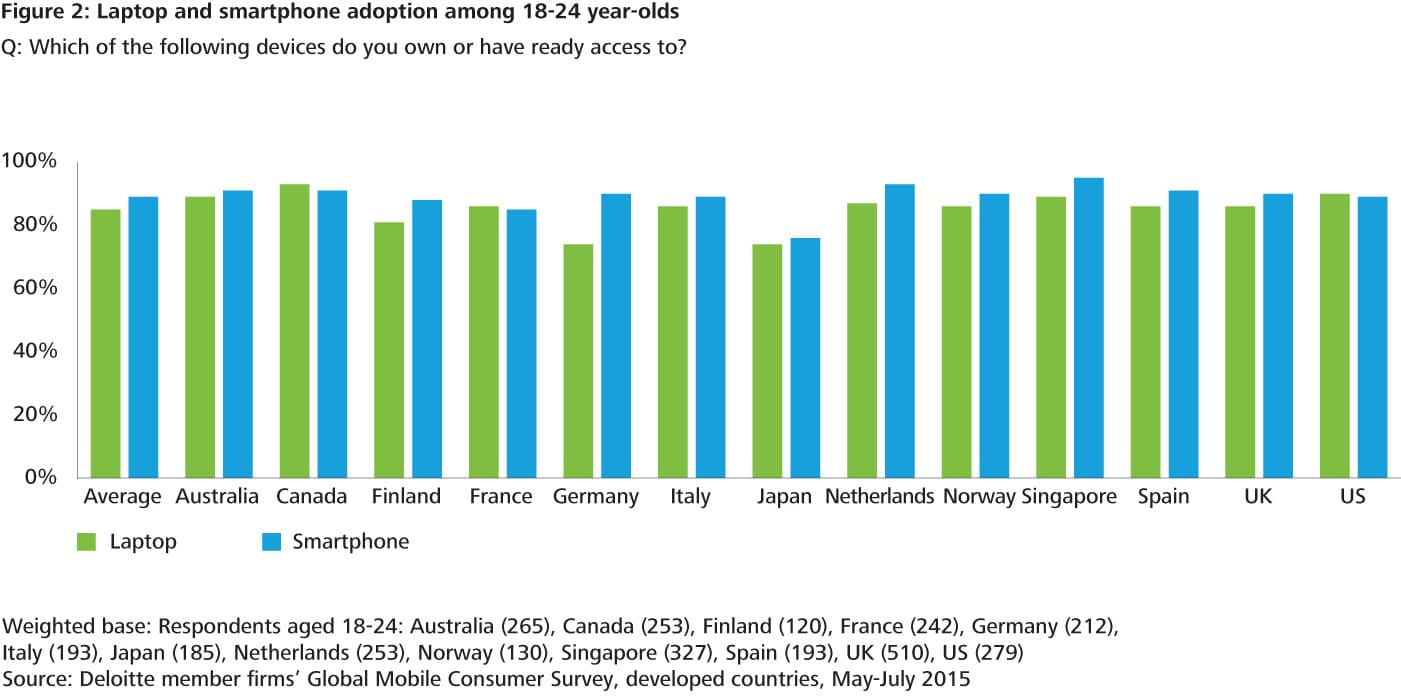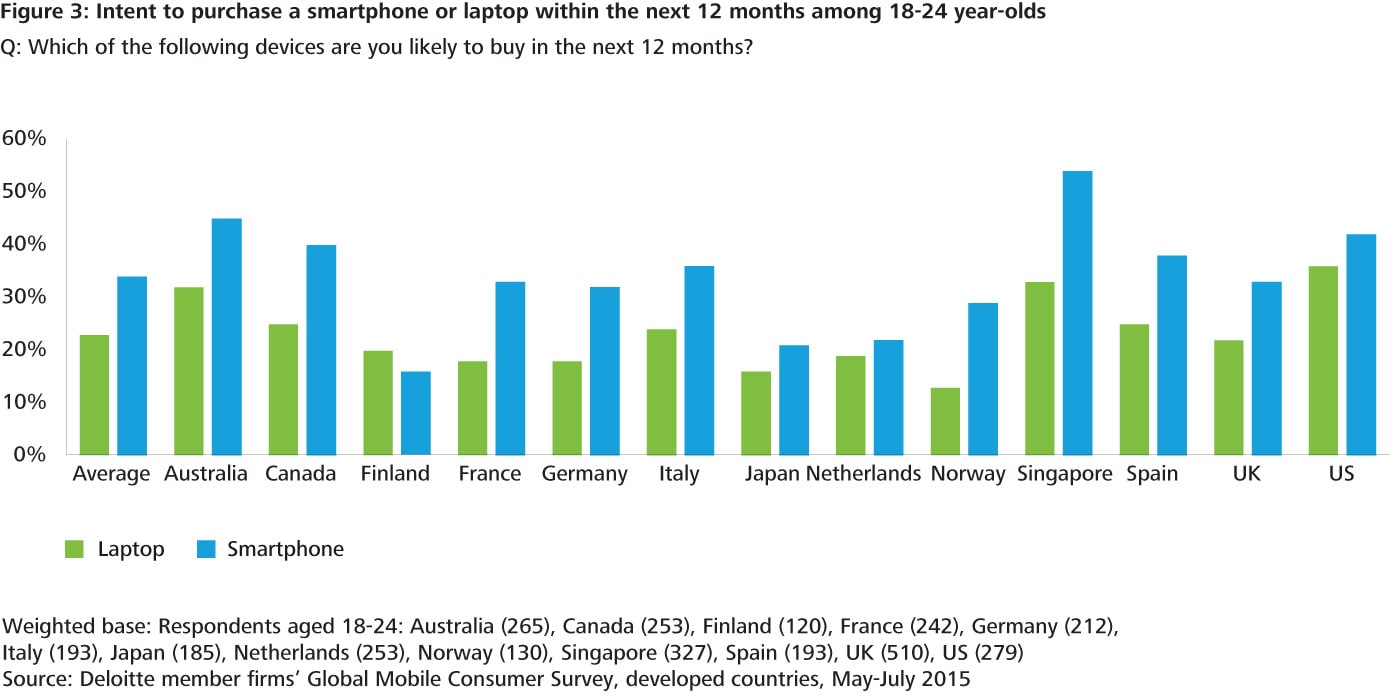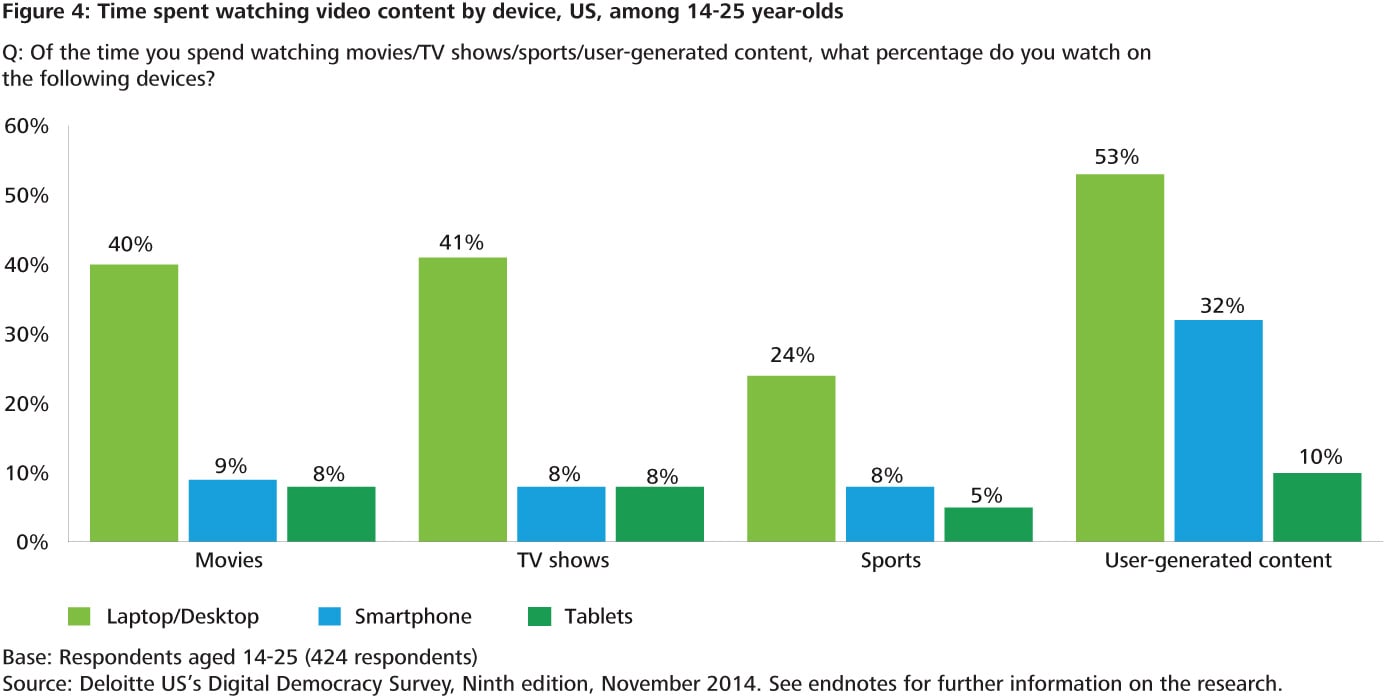Predictions

Trailing millennials are the pro-PC, not the post-PC, generation
TMT Predictions 2016
Executive summary
Deloitte Global predicts that trailing millennials (18-24 years old) are likely to be the most pro-PC of all age groups in 2016. Although they are the smartphone generation, that does not mean they are abandoning their personal computers. In fact, their ownership, intent to purchase and use of PCs (regardless of operating system) will likely be higher than for any other age group in 2016.
It seems that 18-24 year-olds view smartphones and PCs as complements, not substitutes. This may be partly because laptops are more affordable than ever before, with many sub-$500 devices now available. The large screens, keyboards and trackpads or mice of a laptop provide an ease of input and display that even the largest phablet can’t match.
Having a mobile strategy will be necessary in 2016, especially if your market is millennials. In fact, a mobile-first strategy is almost certainly a good idea. But a mobile-only strategy that assumes millennials have already abandoned (or are about to abandon) their computers is almost certainly an equally bad idea. Depending on the content or use case, millennials still use PCs, and sometimes even prefer the PC to mobile.
For example, in a Deloitte US survey published in 2015, trailing millennials 14-25 years old reported the percentage of time spent watching four different forms of video content: for smartphones, tablets, desktop/laptop computers and TV sets. Aside from TV sets, the computer screen was the dominant device, even for user-generated content. In fact, for movies and TV shows (30-60 minutes), millennial use of computers was more than double the screen time for smartphones and tablets combined. Although games and social media are indeed heavily mobile-first for trailing millennials, the larger screens on desktops and laptops seems to be preferred to mobile.
Another example is online banking. According to a 2014 US study, 20-34 year-olds were much more likely than any other demographic to conduct banking-related activities via digital channels. However, when asked to express a preference, millennials preferred banking via web site more than two-to-one over mobile.
Shopping is another use where the PC still has its place. A 2014 survey of US 19-33 year-olds showed they prefer using a computer rather than a smartphone or tablet for checking product details or availability, and especially for making the actual purchase, with nearly two-thirds preferring a computer, and only about 40 percent using a smartphone or tablet.
According to a comScore study, millennials in all of the US, UK and Canada are definitely mobile-first: in each country 18-34 year-olds spend at least 20 hours more per month on mobile than on laptop or desktop PCs. American millennials spend 90 hours per month on their mobiles, nearly 50 hours more than on their computers. However, that does not mean they have abandoned their PCs: millennial PC usage is 39-46 hours per month across the three countries, which is a little less than usage for the study population as a whole (about two hours per month), but not materially so.
Millennials seem more than willing to have a laptop in front of them and a smartphone in hand. What are millennials doing on PCs? The answer is computer games, longer-form video, downloading or streaming content, and creating or editing content (text, videos). In fact, when we look at how PCs compete with tablets or smartphones, and how they are used by demographic groups, it might be those aged 55 and over who are more likely to become the post-PC generation.
1 For a complete list of references and footnotes, please download the full PDF version of the TMT Predictions 2016 report.
Deloitte Global predicts that trailing millennials (18-24 years old) are likely to be the most pro-PC of all age groups in 2016. They are very unlikely to be post-PC and abandon personal computers (any operating system). This age group is the smartphone generation, but its ownership, intent to purchase and use of PCs will likely be higher than any other age group in 2016.
According to research by Deloitte member firms on average over 85 percent of trailing millennials in 13 developed countries had access to a laptop in 2015. This is a little lower than the 89 percent who have access to a smartphone in these markets (see Figure 2). In most countries access to smartphones is slightly higher, but in the US, France, and Canada more 18-24 year-olds have access to a laptop than a smartphone. Further, laptop access for the trailing millennial demographic was either highest or second highest of the six age groups in the survey in all but two markets, Norway and Finland. Access to a laptop among trailing millennials was seven percent higher than for the population as a whole, and in some countries was much higher than the average: 17 percent in the US, 15 percent in Canada, 12 percent in Australia and 10 percent in France.
It appears that 18-24 year-olds consider smartphones and PCs as complements, not substitutes. This may be partly because laptops are more affordable than they once were, with many sub-$500 devices available. Trailing millennials in developed countries may not have to choose between a PC and a smartphone. The large screens, keyboards and trackpads or mice of the laptop provide an ease of input and display that is superior to even the largest phablet. It appears millennials (and other age groups) are more than willing to have a laptop open in front of them and hold a smartphone in their other hand.
When it comes to substitution, it appears to be the large tablet (nine inches or larger) that is being partly passed over by 18-24 year-olds. In every country surveyed, access to laptops for trailing millennials was between 38 and 60 percentage points more than access to large
Question: Which of the following devices do you own or have ready access to?

Weighted base: Respondents aged 18-24: Australia (265), Canada (253), Finland (120), France (242), Germany (212), Italy (193), Japan (185), Netherlands (253), Norway (130), Singapore (327), Spain (193), UK (510), US (279)
Source: Deloitte member firms’ Global Mobile Consumer Survey, developed countries, May-July 2015
Trailing millennials are actively interested in acquiring new laptop models. Purchase intent may be at a lower level than for smartphones, along with every other device, but laptops are still the second-most desired device in every country surveyed. About a third of 18-24 year-olds in developed countries surveyed planned to buy a new smartphone in the next 12 months, and a quarter intended to buy a new laptop (see Figure 3). That number is roughly double the percentage of other devices one might expect a post-PC generation to be thinking about buying, such as tablets, wearables or portable games players. Once again, the intent-to-purchase data for laptops for millennials was higher than for any other age group in 12 of the 13 countries surveyed, with Norway as the only exception.
Question: Which of the following devices are you likely to buy in the next 12 months?

Weighted base: Respondents aged 18-24: Australia (265), Canada (253), Finland (120), France (242), Germany (212), Italy (193), Japan (185), Netherlands (253), Norway (130), Singapore (327), Spain (193), UK (510), US (279)
Source: Deloitte member firms’ Global Mobile Consumer Survey, developed countries, May-July 2015
Other Deloitte US research into the US market suggests that 14-25 year-olds rank laptops among their most valued devices. About three-quarters of 14-25 year-olds placed laptops and smartphones in their top three valued devices. That percentage was higher than laptop ranking for any other demographic studied. It was also much higher than any other device for trailing millennials, whose next top-ranked devices were gaming consoles, flat-panel TV and desktop computers at 45, 40 and 35 percent respectively.
Further, the younger millennials appear to be getting good use out of their computers. Studies suggest that 18-24 year-olds in the US spend 49 minutes per day using the Internet or watching video on a PC in addition to email, games, and work/study applications such as word processing. That 49 minutes per day is less than older Americans (35-49 year-olds are using the Internet or watching video on their computers 69 minutes per day) but it does not suggest that the younger group is about to abandon their laptops or desktops in the near future. But the same data shows that millennials make use of their
Daily time spent on all media reflects the same trend. Another study found that millennials (18-34 years old, not just trailing millennials) use mobile devices (smartphones and tablets) quite frequently, spending a third of total media time on them. Desktop and laptop computers are close behind at 27 percent of total media time: which is more than for the adult population as a whole (only 21 percent); and higher than the percentage of time millennials spend on traditional TV (23 percent). In fact, based on time spent, millennials are closer to being the post-TV generation than the post-PC generation.
In a comScore study, millennials in all of the US, UK and Canada are definitely mobile-first: in each
Looking at media platform usage by all adult Americans (and not only trailing millennials,) there has been enormous growth in time spent on digital mobile devices, from 19 minutes daily in 2008 to 171 minutes in 2015, an 800 percent growth over only seven years. In the same period, TV usage has been flat; up only a minute per day to 255 minutes; and other connected digital devices (such as gaming consoles connected to the Internet) have grown to 25 minutes per day from nine. But time spent on print newspapers, print magazines, and broadcast radio all fell sharply: their combined daily time fell from 165 minutes to 109 minutes, a 33 percent decline.
Mobile usage for adult Americans appears to be a mix of additive and substitutional.It has increased the total cumulative time per day people spend consuming media across all platforms, from 578 minutes in 2008 to 701 minutes in 2015, or over 20 percent, although there is also some growth in simultaneous usage with the rise of the second screen. Smartphones and tablets have become the digital devices of choice for media
It seems likely the trend for mobile media usage taking over
What are millennials doing on PCs? The answer is computer games, longer-form video, downloading or streaming content, and creating or editing content (text, videos). In fact, when we look at how PCs compete with tablets or smartphones, and how they are used by demographic groups, it might be those aged 55 and over who are more likely to become the post-PC generation.
There are also age and cohort effects at work. As today’s 18-24 year-olds grow older, it seems likely that their PC use may rise when they are 25-34, and then possibly increase again when they are 35-49, which is the age group that currently uses computers the most per day in the US. After that, and as they begin to spend less time playing complex PC-based games, moving increasingly to legal sources of content, and shift from being content creators to spending more time exclusively consuming or reviewing content, their PC usage is likely to fall and shift towards tablets. But it seems equally probable that the cohort of 18-24 year-olds of 2020 or 2025 will still use devices that are more or less PC-like: they will have full-size keyboards, much larger screens, and pointing devices that are more precise than a finger on a screen. Based on recent trends, they are likely to use those devices for fewer minutes per day than today’s 18-24 year-olds use their computers, but it will still be a significant device: widely-owned, widely-valued, often required by schools or employers, and used for hours per week.
Bottom line
It appears that having a mobile strategy will be
One excellent example of this distinction is video content. In a Deloitte US survey published in 2015, trailing millennials 14-25 years old reported the percentage of time spent watching four different forms of video content: for smartphones, tablets, desktop/laptop computers and TV sets. As Figure 3 shows, leaving TV sets aside, the computer screen was the dominant device, even for user-generated content. In fact, for movies and TV shows (30-60 minutes), millennial use of computers was more than double the screen time for smartphones and tablets combined. Although games and social media are indeed heavily mobile-first for trailing millennials, the larger screens of desktops and laptops
Question: Of the time you spend watching movies/TV shows/sports/user-generated content, what percentage do you watch on the following devices?

Base: Respondents aged 14-25 (424 respondents)
Source: Deloitte US’s Digital Democracy Survey, Ninth edition, November 2014. See endnotes for further information on the research.
Another example is online banking. According to a 2014 US study, 20-34 year-olds were much more likely than any other demographic to conduct banking-related activities via digital channels, with 65-80 percent using digital to make internal transfers, check for fraudulent charges or check account balances. They were also the most likely to use the bank’s mobile app: more than twice as likely as Generation X (
Shopping is another use where the PC still has its place. US

@DeloitteTMT